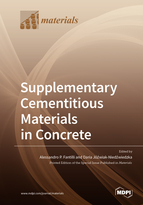Supplementary Cementitious Materials in Concrete
A special issue of Materials (ISSN 1996-1944). This special issue belongs to the section "Construction and Building Materials".
Deadline for manuscript submissions: closed (31 March 2021) | Viewed by 72153
Special Issue Editors
Interests: high-performance fiber-reinforced concretes; concrete made from recycled aggregates from tires; eco-mechanical indices of concrete; concretes made from recycled aggregates from demolition
Special Issues, Collections and Topics in MDPI journals
Interests: durability of cement-based composites; microstructure analysis; transport properties; high performance materials exposed to combined action of environmental loads and nuclear radiation
Special Issues, Collections and Topics in MDPI journals
Special Issue Information
Dear Colleagues,
The environmental impact of the Portland cement production and the large use of cement-based building materials are a growing concern. The substitution strategy, consisting of the partial replacement of Portland cement with supplementary cementitious materials (SCMs) or the more common application of blended cements, is an effective way to improve the sustainability of the cement and concrete industries. The development of new combustion technologies and the introduction of new materials affect the physical and chemical properties of SCMs, which further results in enhancing some concrete properties (performance strategy).
The forthcoming Special Issue of Materials aims to recognize the current state of knowledge and development in the use of SCMs within the substitution and performance strategies. It is our pleasure to invite you to submit your research article, communication, or review in which the following aspects of SCMs are investigated:
- Measuring the chemical, physical and mineralogical properties of SCMs, before and after hydration;
- Defining the amounts and the types of SCMs in accordance with the desired effects on fresh and hardened concrete performances;
- Designing structural elements made with normal and high-performance concretes containing SCMs;
- Assessing the durability and environmental impact of cement-based materials and structures, when SCMs are used to substitute, or in conjuction with, hydraulic cements.
Prof. Alessandro P. Fantilli
Dr. Daria Jóźwiak-Niedźwiedzka
Guest Editors
Manuscript Submission Information
Manuscripts should be submitted online at www.mdpi.com by registering and logging in to this website. Once you are registered, click here to go to the submission form. Manuscripts can be submitted until the deadline. All submissions that pass pre-check are peer-reviewed. Accepted papers will be published continuously in the journal (as soon as accepted) and will be listed together on the special issue website. Research articles, review articles as well as short communications are invited. For planned papers, a title and short abstract (about 100 words) can be sent to the Editorial Office for announcement on this website.
Submitted manuscripts should not have been published previously, nor be under consideration for publication elsewhere (except conference proceedings papers). All manuscripts are thoroughly refereed through a single-blind peer-review process. A guide for authors and other relevant information for submission of manuscripts is available on the Instructions for Authors page. Materials is an international peer-reviewed open access semimonthly journal published by MDPI.
Please visit the Instructions for Authors page before submitting a manuscript. The Article Processing Charge (APC) for publication in this open access journal is 2600 CHF (Swiss Francs). Submitted papers should be well formatted and use good English. Authors may use MDPI's English editing service prior to publication or during author revisions.
Keywords
- Material design and optimization of the structure of materials
- Structural performances
- Models of new materials and prediction of their properties
- Manufacturing processes
- Durability and sustainability assessment







